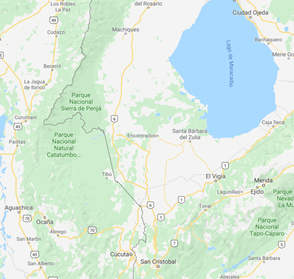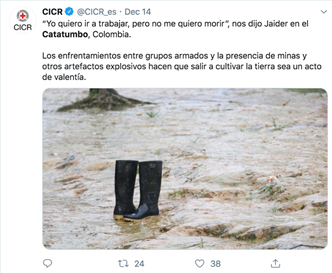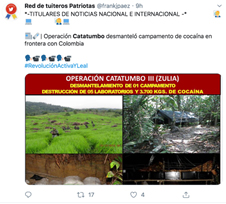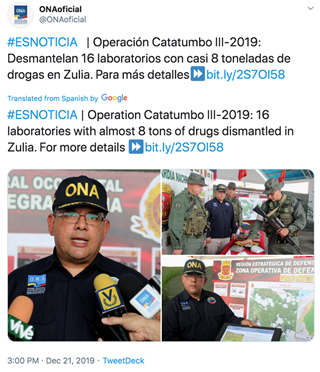The War in Catatumbo: Taking Stock of an Underreported War
Cooper Strand
In August 2019, Human Rights Watch published a report on a new war that is sweeping across the Catatumbo region of northeastern Colombia. That same month, numerous articles were published regarding the conflict, but since then, little has been written or reported on the situation by western mainstream media sources. Of course, the conflict has continued despite this lack of coverage, and the situation has gotten more volatile as it has unfolded. The War in Catatumbo is a convergence of numerous larger issues that plague the region: Armed conflict between government forces, paramilitary groups, and drug cartels; large amounts of internally displaced Colombians and internationally displaced Venezuelans; and rampant human rights abuses by warring factions vying for control of the area. Truly, Catatumbo seems to be a singular location where some of Latin America’s biggest problems converge, and the local population is suffering for it. This paper intends to take stock of the war’s history, its current status, and to make an argument that the War in Catatumbo deserves more attention from the international community than it is currently receiving. This attention should come in the form of increased media coverage to bring the region’s issues to light, and from increased NGO involvement to relieve the ongoing humanitarian crisis occurring in the region. Additionally, the international community should review the policy prescriptions from the August 2019 Human Rights Watch report, and work to integrate these prescriptions into its practices.
The History
According to the Human Rights Watch, The Catatumbo region of northeastern Colombia and Venezuela describes the area surrounding the Catatumbo River Basin8. This roughly 1800 square mile area includes 11 municipalities in the Norte de Santander department, the Natural Catatumbo Barí National Park, and the Catatumbo River8. The region includes a 50/50 urban-rural population of 300,000 spread out among wide stretches of sparsely populated jungle, but also numerous towns and cities, the largest of which being Ocaña, Colombia. The rural nature of the population, isolated location far from government-ran cities, and thick jungle in some areas has kept it free from significant government oversight. This has made it an ideal place for the growth of the coca plant, a central ingredient in the manufacture of cocaine and key to the Colombian drug trade2. As a result, this region was the scene of much violence during the Colombian Civil War. But the recent development of the conflict in Catatumbo cannot be discussed further without first reviewing the larger unrest in Colombia, a civil war which has had huge ramifications for the country and its people.

Photo showing a rough outline of the Catatumbo Region of Colombia. Courtesy of Scribblemaps.com. Retrieved 21 December 2019.

The above highlighted Catatumbo Region. Note the town of Ocaña, the largest settlement in the region, as well as Natural Catatumbo Barí National Park. Courtesy of Google Maps. Retrieved 21 December 2019.
Throughout the 20th and 21st centuries, Colombia’s story has been one of violence and political strife. The Colombian Civil War officially began in 1964 when several paramilitary groups began active campaigns of revolution against the Colombian government. The two largest of such groups, the Revolutionary Armed Forces of Colombia (FARC) and National Liberation Army (ELN), were two of these original organizations that formed under the Communist ideology and purportedly aimed to reduce wealth inequality in the country1. Since the 1960s, more than 220,000 people have been killed in the fighting, with at least 5 million being displaced3. The FARC, ELN, and other (smaller) revolutionary groups perpetrated acts of violence against civilians and acts of war against government forces, but an estimated 80% of deaths in the 55 years of fighting have been civilians3. Paramilitary groups soon turned to the illicit drug trade to fund their activities, and in the 1970s, cartels joined in the melee. The paramilitaries and the cartels focused most of their drug production efforts on growing coca in isolated facilities deep in the Colombian jungle where the government could exert less control. With 50% of its population living in rural areas, the Norte de Santander department became an ideal location for such activities, bringing the conflict to the region.
In 2016, Colombian President Juan Manuel Santos signed a historic peace deal with the FARC, which purported to have ended more than 50 years of fighting. President Santos received widespread praise from the international community for his efforts, even receiving the 2016 Nobel Peace Prize. But despite some early successes in disarming the rebels, these hopeful sentiments have proven to be overly-optimistic. In 2019, a faction of FARC objectors to the 2016 peace deal announced that they had resumed their campaign against the government. President Santos’ successor, President Iván Duque, responded to the announcement by authorizing new military operations against the revived FARC6. This announcement put to words a reality that had existed on-the-ground since the deal was signed. The peace treaty had only put the fighting on pause, and it has now resumed in full-force.
While Colombia suffered through decades of unrest, Venezuela dealt with its own ups and downs, though it was markedly less violent a place than its neighbor to the west. In recent years, the former Spanish colony has undergone severe economic decline, hyperinflation, and worsening conditions for its citizens4. In fact, the 2019 Index of Economic Freedom ranked it at 179 out of 186 for most free economies, putting it just below Cuba and just above North Korea, for reference4. In July 2019, the UNHCR, UN Refugee Agency, and IOM announced that the number of refugees fleeing Venezuela has reached 4 million, with 1.3 million of them taking refuge in Colombia5. At least 25,000 of those have taken refuge in the already-volatile Catatumbo region8.
Thus, we return to the new conflict that has grown in Catatumbo. The August 2019 Human Rights Watch report paints a dismal picture of the situation on the ground. The report states that, beginning in 2018, the FARC, ELN, and the Popular Liberation Army (EPL, another anti-government paramilitary group) began operating in the region. The rebel forces are vying for control of local land and coca fields, as well as access to the Venezuelan drug markets which can be reached through the Catatumbo region8, 10. The report also outlines a number of abuses of the local population, to include but not limited to the displacement of some 40,000 local people, kidnappings, child soldier recruitment, sexual violence, and the emplacement of landmines8. Many children are forced to work on coca farms to support the illicit drug trade, rather than go to school9.
Following the release of the Human Rights Watch report, several news agencies such as The Guardian and Americas Quarterly reported on the Catatumbo War. But the war’s coverage has dwindled since then, and as a result it is challenging to get an accurate picture of conditions on-the-ground in Catatumbo. In my search for any bits of timely information that could paint a picture of the current situation, I came across a number of posts to Twitter which happen to provide more information than can be found in western media. The below screenshots were taken from Twitter on the dates listed in the captions. The conclusions drawn from each are listed in the captions as well.

Landmines and other explosives in Catatumbo have made it difficult for farmers to return to work. Source: Twitter. 14 December 2019. https://twitter.com/CICR_es/status/1205921913895342082

Announcing a Colombian military operation in Catatumbo to combat the illicit drug trade in Catatumbo. Source: Twitter. 16 December 2019. https://twitter.com/frankjpaez/status/1206623723232645120

Colombian officials describe the results of the counter-drug operation in Catatumbo. Source: Twitter. 21 December 2019. https://twitter.com/ONAoficial/status/1208477237885820928
Of course, not all news from Twitter can be taken as truth, and each source must be scrutinized for biases and reliability. Twitter is increasingly used as a form of open-source intelligence, with information being collectible from countless sources at great magnitude. While these posts cannot paint us the whole picture of a complicated situation, it does show a continuing trend of violence and unrest in the Catatumbo region, while mainstream western news coverage dwindles.
Another major resource, the English-language, Medellín-based Colombian news website Colombia Reports, has run less than 5 articles in the last few years that even mention ‘Catatumbo.’ More specifically, only one refers to the unrest that is occurring in the region. That article, written by Adriaan Alsema in May 2016, asserts that the government has little to no control over the Catatumbo Region. It goes into further detail, claiming that the drug cartels and paramilitaries are the “de facto authority” in Catatumbo, and many parts of the poverty-stricken area are off-limits to police and outsiders8. Even on Colombian news sites, Catatumbo War updates are hard to find. If the situation was this extreme in 2016, it is hard to imagine it got any better with another four years of media silence.
The Case for Catatumbo
The War in Catatumbo deserves more attention from the international community than it’s currently receiving. The region itself is remarkable in that it’s a true microcosm of the complex issues facing Latin America as a whole: Paramilitary violence, cartel violence, drug manufacturing, and displaced persons have all created a cocktail of instability in Catatumbo7. Truly, just about every major issue in the region can be found on the streets and in the jungles of Catatumbo. These factors have created a large amount of vulnerable people who are being victimized, and even more who could potentially be victimized.
The Human Rights Watch report makes a compelling case for the magnitude of the violence being committed upon the civilians in Catatumbo. Hundreds of murders have been reported, yet only 61 cases have led to convictions8. Landmines, a weapon which seems to disproportionately affect civilians rather than military targets, have killed four and injured 65 in the last three years alone8. Sexual assaults, kidnappings, and recruitment of child soldiers has also occurred in the region8. One woman interviewed in the Human Rights Watch Report told about the walls of her home being filled with bullet holes from guerilla firefights. She stated that she’d had to send her children, ages 14 and 17, to live with a relative after threats by fighters that they’d be forced into the paramilitaries8. This is the reality of many citizens of Catatumbo living in the conflict zone.
The problem of displaced people in Catatumbo is one that could have increasingly dire ramifications if left unchecked. The conflict has already displaced an estimated 40,000 people from within the region, and an additional 25,000 have fled to Catatumbo from Venezuela as they try to escape that country’s unrest8. These large displaced populations are especially vulnerable to recruitment by armed groups, as well as violence and sexual abuse. If the people of Catatumbo are at great risk in the conflict, then the transient, homeless, and jobless displaced refugees are at even greater risk.
The international community must increase its involvement in this conflict, as the Colombian military has unfortunately not proven to be capable of addressing the region’s issues. For the purposes of this paper, my use of the ‘international community’ refers specifically to the international media and non-government agencies (NGOs).
Increased media coverage of the War in Catatumbo would bring to light many of the crimes being committed in the region. The daily news coverage of the violence, as well as government operations to curb that violence, would bring more awareness to the rest of the world. It would also provide incentive for the Colombian government to make significant efforts to bring stability to the region. As media coverage and awareness increases, greater demand would be created for NGOs to act in the Catatumbo War. These humanitarian organizations would help deal with the refugee crisis and protect vulnerable people from being exploited by armed groups. Additionally, the Human Rights Watch report makes a number of policy recommendations to the Colombian government, from the local level to the national level. These recommendations are an excellent place to start for any NGO seeking ways to get more involved in the region as they make it a priority to protect citizens from abuses, assist refugees, and prosecute crimes committed by armed groups.
The people of Catatumbo require greater stability, and freedom from violence. And while the international community could raise awareness and bring in humanitarian aid, the reality is that the situation on the ground will not meaningfully improve until the conflict itself is dealt with by government forces. Most of the region’s problems center around its desirable location for coca growth. Coca fields need to be removed and replaced with sustainable agriculture that will give the locals other methods of making a living. The porous border, which allows for drugs to be trafficked with ease into Venezuelan markets, should be strengthened, forcing armed groups to find other routes. Likely, the Colombian military is aware of these requirements, but does not have the resources to bring about meaningful change to an area so far ‘off the beaten path.’ Just as the Catatumbo War has created a microcosm of the issues facing the region, so it shows how little security the government can truly provide for its citizens in far-off parts of the country. So, the final role that the international community should play in this conflict is to put pressure on the Colombian government to create meaningful change in the region through a combination of military security operations, increased funding and manpower for policing, resources for refugees, and increased education and job prospects for those in the region. The international community should also continue to offer assistance to the Colombian government as it carries out these measures.
Bibliography
- “Who are the FARC?” BBC News. BBC, November 24, 2016. https://www.bbc.com/news/world-latin-america-36605769.
- “Catatumbo: Colombia Reports.” Colombia News. Colombia Reports, August 9, 2019. https://colombiareports.com/catatumbo/.
- Salcedo, Victor. “Memories of War and Dignity: Report on Victims of Colombia's Conflict.” Security Assistance Monitor, July 25, 2013. http://www.securityassistance.org/blog/memories-war-and-dignity-report-victims-colombias-conflict.
- “Venezuela Economy: Population, GDP, Inflation, Business, Trade, FDI, Corruption.” The Heritage Foundation, 2019. https://www.heritage.org/index/country/venezuela.
- United Nations. “Refugees and Migrants from Venezuela Top 4 Million: UNHCR and IOM.” UNHCR: The UN Refugee Agency, June 7, 2019. https://www.unhcr.org/en-us/news/press/2019/6/5cfa2a4a4/refugees-migrants-venezuela-top-4-million-unhcr-iom.html.
- Grattan, Steven. “Colombia's Duque Seeks Arrest of Rearmed Ex-FARC Leaders.” Colombia News | Al Jazeera. Al Jazeera, August 29, 2019. https://www.aljazeera.com/news/2019/08/colombia-duque-seeks-arrest-rearmed-farc-leaders-190829200112859.html.
- Moloney, Anastasia. “Rising Tensions as Colombia's Displaced Converge with Venezuelan Migrants.” Reuters. Thomson Reuters, January 29, 2019. https://www.reuters.com/article/us-colombia-displacement-venezuela/rising-tensions-as-colombias-displaced-converge-with-venezuelan-migrants-idUSKCN1PN34O.
- “The War in Catatumbo: Abuses by Armed Groups Against Civilians Including Venezuelan Exiles in Northeastern Colombia.” Human Rights Watch, August 8, 2019. https://www.hrw.org/report/2019/08/08/war-catatumbo/abuses-armed-groups-against-civilians-including-venezuelan-exiles.
- Broner, Tamara Taraciuk, and Juan Pappier. “The War at the Colombia-Venezuela Border.” Americas Quarterly, August 28, 2019. https://www.americasquarterly.org/content/war-colombia-venezuela-border.
- Braunschweiger, Amy. “Interview: The War in Colombia's Catatumbo Region.” Human Rights Watch, August 8, 2019. https://www.hrw.org/news/2019/08/08/interview-war-colombias-catatumbo-region.
About the Author(s)
Comments
We are committed to…
We are committed to providing our clients with exceptional solutions while offering web design and development services, graphic design services, organic SEO services, social media services, digital marketing services, server management services and Graphic Design Company in USA.
